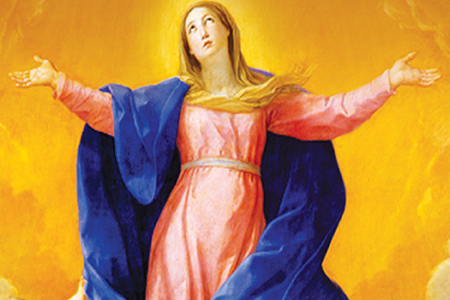 Proverbs 9:1-6
Proverbs 9:1-6
 Ephesians 5:15 - 20
Ephesians 5:15 - 20
 John 6:51 - 58
John 6:51 - 58
This Sunday the Church celebrates the feast day of the Assumption of the Virgin Mary. Believed to be the oldest feast day of Our Lady, yet it is not known how the celebration first came about (Ref. EWTN.com).
Since ancient times, the Christians in Jerusalem have honored the place where Mary lived and died on Mount Zion, the first center of life of the early Church and the Christian community (See Footnote). It is in Zion that Jesus celebrates the Last Supper before his Passion; where He appears to his Apostles and shows them his wounds after His Resurrection; and where the Holy Spirit descends upon Mary, the Apostles and the first followers of Jesus at Pentecost. From Zion after Pentecost, the Apostles travelled afar to spread the good news of Jesus Christ.
Then Mary was dying. Early Christians have passed on the traditional belief that the Apostles returned from their missionary journeys and gathered at Mary's death bed. The belief that Mary had been taken up, body and soul, into heaven also came from the apostles; there were no relics of Mary to be venerated, and that an empty tomb stood on the edge of Jerusalem near the site of her death on Mount Zion, now the site of The Basilica of the Dormition (falling asleep) of Mary, and home of the Benedictine Abbey. “The Basilica stands on old stone and oral testimonies of Christian belief” said the Benedictines in the Abbey’s web page. Over the centuries, local Christians have preserved two stones in the Basilica that they honored as stones from the house where Mary lived and died. (Ref. “Domitio”, web site of the Benedictine Abbey).
In 1950, Pope Pius XII declared The Assumption of the Virgin Mary a dogma of the Church. In his Apostolic Constitution – Munificentissimus Deus (Defining the Dogma of the Assumption) – he said that this is “a divinely revealed dogma: that the Immaculate Mother of God, the ever Virgin Mary, having completed the course of her earthly life, was assumed body and soul into heavenly glory”. By his Passion, Christ overcomes sin and death. Through Baptism, the faithful have been born again in a supernatural way, having conquered sin and death through the same Christ. Yet, generally, it is not the will of God to grant to the righteous the full effect of victory over death until the end of time (Ref. Daniel 12:2, Isaiah 26:19, 1 Cor 15:22-23). So their bodies are corrupted after death, and only on the last day will they be joined to their souls. But since the Virgin Mary completely overcame sin by her Immaculate Conception – that Pope Pius IX solemnly proclaimed as dogma – her body was not subject to corruption in the grave, and she did not have to wait until the end of time for the redemption of her body. (Ref. Munificentissimus Deus para 4, 5, 44).
After receiving the Annunciation from angel Gabriel that she was to bear a son and “The holy child to be born shall be called Son of God”, “Jesus” (Lk 1:35, 31), Mary visited her cousin Elizabeth, whom as revealed by the angel, was also expecting a child in her old age. In this week’s gospel reading, we hear the overflow of joy from the exchange of greetings between them. Filled with the Holy Spirit, Elizabeth’s exclamation, “Blessed are you among women, and blessed is the fruit of your womb” would become part of the “Hail Mary” prayer that the faithful all over the world pray fervently to our heavenly Mother every day (Lk 1:42). Mary’s response “The Magnificat” is her beautiful Song of Praise to Almighty God, “My soul magnifies the Lord, my spirit rejoices in God my Saviour” (Lk 1:46-47). She exalts humility; therefore, we must humble ourselves and acknowledge our nothingness to God in absolute submission, “He has looked upon His servant in her lowliness, and people forever will call me blessed” (Lk 1:48). It is a song of thanksgiving for the fullness of salvific grace “He has helped his servant Israel” whose hope is met by the fulfilment of the promises made to our ancestors, "to Abraham and to his posterity forever”(Lk 1:54, 55). (Ref. Ignatius Catholic Study Bible New Testament P 106; CCC 2097, 2619).
Our heavenly Mother is a perfect role model for us in faith and holiness, humility and total submission to God. She is also our most gracious Advocate who would turn her eyes of mercy towards us and intercede for us.
Footnote: Another tradition traced Mary’s last years to a place near Ephesus, where she lived in a small house purportedly built by the Apostle John.
